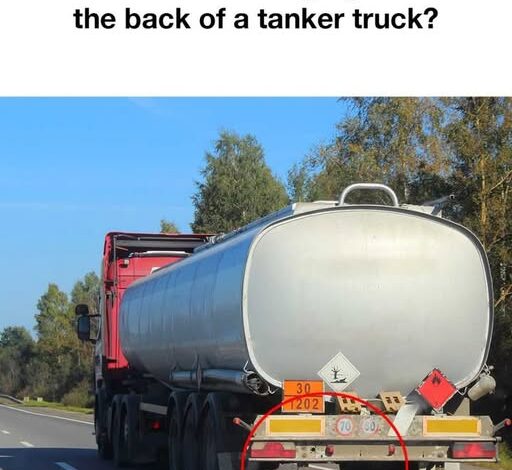
Tank trucks are built to look tough and heavy-duty, but one of their most important safety features is also the easiest to overlook. Hanging near the rear bumper, almost dragging along the pavement, is a simple metal chain. Most people glance at it and assume it’s decorative, outdated, or maybe something to keep the truck steady. But that tiny piece of metal quietly prevents disasters every single day.
Inside every tanker, especially those hauling fuel, chemicals, or other volatile liquids, constant motion creates friction. Liquids slosh back and forth. The metal tank vibrates and rubs against its own frame. Tires spin against asphalt. Air rushes past the vehicle at high speeds. All of this motion builds static electricity — the same kind of charge that shocks your fingertips when you touch a doorknob, but magnified to life-threatening levels. If those charges build up too high and release as a spark, the entire truck becomes an ignition point. And when a vehicle is full of flammable cargo, one spark is all it takes to create an explosion.
That’s exactly why the grounding chain exists.
It’s not glamorous. It’s not high-tech. But it’s brilliant in its simplicity. As the truck rolls down the road, the chain bounces and scrapes along the ground. That constant contact gives electricity an escape route — a path from the truck’s metal body into the earth. Instead of building up and waiting to strike, the charge is released safely and consistently. The chain is essentially a lifeline, one that keeps both the driver and everyone around them safe.
This wasn’t always common practice. Decades ago, tanker explosions caused by static buildup were far more frequent. Investigations traced many of them back to small sparks that ignited vapors around the truck. The fix was cheap, effective, and easy to implement, so the industry adopted grounding chains across the board. Over time, they became standard equipment, and safety regulations tightened. Inspectors from the U.S. Department of Transportation and similar agencies worldwide now check that grounding systems — including chains — are intact and functioning. It’s a non-negotiable requirement.
Still, many people misunderstand the chain’s purpose. Some think it helps stabilize the truck. Others assume it’s there to reduce swaying, vibrations, or noise. Some believe it’s outdated and unnecessary, replaced completely by new technologies. But experts disagree. Modern safety systems do exist: retractable grounding reels, anti-static fluids, advanced bonding straps, and electronic discharge monitors. They’re helpful, but they don’t fully replace the chain’s reliability. Technology can glitch. Electronics can fail. A simple metal chain rubbing the road? That almost never does.
More importantly, the chain works whether the driver remembers it or not. It isn’t a switch. It’s not something that needs activation. Its job never stops, and it never requires a human to think about it. The moment the truck moves, the chain does its work.
Of course, like anything exposed to weather, friction, and heavy use, grounding chains need maintenance. Road salt corrodes metal. Repeated scraping against concrete wears down the links. If the chain becomes too short to touch the ground, it’s useless. Drivers and mechanics are trained to check it regularly, making sure it’s long enough, strong enough, and free of breaks. A single worn link can compromise the whole mechanism.
To most drivers on the road, the chain is invisible. They pass by tanker trucks at full speed, never realizing that something as small as a spark could put their lives at risk if not for that simple protective strip of metal. It’s easy to forget how fragile safety can be — how many disasters are prevented not by flashy innovations but by humble tools doing their job quietly in the background.
Tanker trucks play an essential role in everyday life. They deliver the fuel that powers our cars, the chemicals that make our goods, the industrial liquids needed for everything from farming to manufacturing. We depend on those shipments just to keep our cities running. With so much riding on these vehicles, every safety measure matters.
The grounding chain is a perfect example of an overlooked solution that saves countless lives. It doesn’t draw attention. It doesn’t need recognition. It simply does what it was designed to do — discharge static electricity before it becomes a threat.
In an age obsessed with cutting-edge technology, it’s easy to underestimate tools that seem old-fashioned. But sometimes the simplest answer remains the best one. A thin metal chain, barely noticeable to the average person, is a quiet guardian protecting drivers, neighborhoods, highways, and entire communities.
Every time a tanker truck rolls safely down the road, that chain plays a part in preventing tragedy. And while high-tech systems continue to evolve, there’s no replacing the reliability of constant ground contact — an unbroken link between the machine and the earth beneath it.
In the end, the chain doesn’t just protect the truck. It protects everyone around it: people at gas stations, families driving alongside, workers unloading flammable cargo, and entire neighborhoods that would be devastated by a fuel explosion.
It’s a reminder that safety doesn’t always look impressive. Sometimes it’s a few feet of rattling metal doing the job nobody notices, yet everyone depends on.